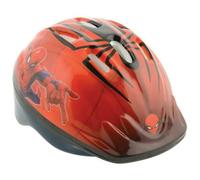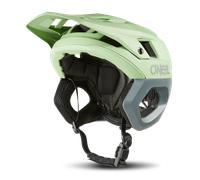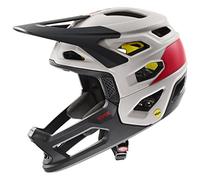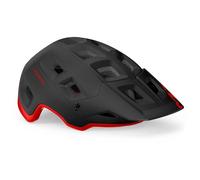Note: This text was created with the help of AI.








































- 1
- 2
- 3
- 4
- 5
- next page
Bike Helmets
No. There are currently no legal requirements to wear a bike helmet.
Even though there are currently no laws that require you to wear a helmet, you should think about your own safety and therefore wear a helmet when cycling. The ADAC recommends that children, young people and sporty cyclists in particular wear a helmet for protection.
Bike helmets are made of hard foam, which has shock-absorbing properties and serves as a "crumple zone" for your head.
Microshell helmets have a thin plastic cover and are the most common. These models are made of thin polycarbonate, which is primarily found in lightweight sports models.
The hardshell helmets have a hard plastic cover around the foam (polystyrene foam) and are mainly used for downhill riding due to their high weight. The "hardshell" material is made of ABS (acrylonitrile butadiene styrene) and is somewhat stronger and heavier, which is why it is also used in motorcycle helmets.
The straps of the helmets are made of polyester and the buckles are made of solid polyamide or POM (polyoxymethylene).
The materials used in the manufacture of the helmets can be found online in the article information or in the product instructions.
Your helmet fits properly when it covers your forehead from about three centimetres above the eyebrows. At the back of your head, the bike helmet should extend to the base of your neck.
The helmet should fit your head snugly, but not too tightly, and above all it should not slip. The straps should not be twisted. If this is the case, put your helmet on straight and bring the straps down so that they pass in front of and behind your ear.
Then you can close the chin strap buckle, which should rest under your chin when the chin strap is taut.
If your bike helmet has a knob at the back, you can adjust it individually to your head shape so that it neither slips nor presses.
The best way to measure your head circumference is with a tape measure. If you do not have a tape measure, you can alternatively measure your head with a thread and hold it against a ruler or folding rule to determine the circumference.
It is advisable to measure above the ears and across the middle of the forehead, about three centimetres above the eyebrows. You should not stretch the tape measure over your neck, but keep it on your head.
I recommend that you measure a second time to get the correct measurement.
For safety reasons as well as for comfort, your child should wear a bike helmet that fits and that he or she does not have to grow into.
The right bicycle helmet size or the size of the head cannot simply be divided into age groups, but depends on the individual child.
You will find the following guidelines for children on the market, which may vary slightly depending on the manufacturer and brand:
| Helmet size | Head circumference | Age |
| XS | 44 to 49 centimeter | 0 till 3 years |
| S | 46 to 51 centimeter | 2 to 7 years |
| S/M | 49 to 53 centimeters | 3 to 9 years |
| M | 52 to 58 centimeters | 4 to 80 + years |
You should not rely on these general values, but measure your child's head exactly to determine the appropriate size.
As the legislator in UK has not yet made helmets compulsory for cycling, this also applies to children.
However, there is a general recommendation for cyclists to wear a bicycle helmet when riding in traffic. Especially for children under the age of twelve, experts strongly recommend wearing a bike helmet.
You should think of your child's safety first and foremost and therefore always let your child wear a helmet when riding a bike.
After every fall or accident. Even if you do not see any damage on the outside, the helmet may have fine hairline cracks that considerably reduce the protective effect during the next fall.
The materials of a helmet are also subject to ageing. This reduces the protective effect of the material, which is why you should replace your bike helmet after about three to five years.
Too much UV light can also damage the plastics and adhesives. Therefore, you should not store your bike helmet in the sun or in a warm car, as the shell of the helmet can deform.
Bike Helmets
Buying a bike helmet is the first thing you should do when you purchase a bike. It doesn't matter whether you've chosen a mountain, road or city model.The reason? In the event of an accident or fall, it can save your life. It's as simple as that. That's why we at pricehunter.co.uk want to give you a hand when it comes to choosing the best cheap bike helmet.
The importance of size when buying a bike helmet
It's the first thing you should look out for. Also, it's not something that usually influences when choosing a cheap bike helmet. Most manufacturers offer three options:
- Size S. Between 52 cm and 54 cm.
- Size M. Between 55 cm and 57 cm.
- Size L. Between 58 cm and 60 cm.
But how can you know which is the exact size of the cheap bike helmet recommended for you? It's very easy. All you need is a flexible tape measure. Make it go around your head passing just above the eyebrows and, according to the measurement thrown, choose the right size. Remember, too, that the best bike helmets for women, men and children have a wheel at the back for adjustment.
Safety, a key factor when choosing a bike helmet deal
There is one thing that, for safety, you should check when visiting a bike helmet shop. There is an EU-wide regulation that governs the minimum safety standards that these protective elements must meet. We are talking about the European Directive 89/686/EEC, which regulates the EN1078 type approval certificate.
So, before you go to the checkout to buy a bicycle helmet, take a look at its label or technical data sheet and check that it has the CE EN1078 certificate. This is the only way to be sure that it is safe.
However, this certificate only sets minimum safety standards. Based on these, manufacturers can add improvements. For example, the best bike helmets best bike helmets are made in one piece. On the other hand, the cheapest ones have a polystyrene interior and a polypropylene exterior.
There are other safety technologies that influence the price when choosing a bicycle helmet. This is the case, for example, of Giro's shock absorption system (MIPS) or graphene as the main material in those of Catlike.
Which bike helmet to buy? Types
In this sense, the choice of one cheap bike helmet or another will depend on the type of bike you have and the modality you usually practice:
- MTB helmets. Specially designed for mountain biking. Their ventilation holes work well even at low speeds. They also have visors to protect your vision from the sun and special padding to reduce the risk of hitting rocks. There are those that only cover the top of the head, but those of modalities such as Enduro and similar ones cover the entire head. In fact, they are very similar to those used by motorcyclists.
- Recreational bicycle helmets. Those generally used to circulate in the city. They have more original, elegant and eye-catching designs and are usually used when riding urban bikes.
- Road helmets. Those specifically designed to practice road cycling. In this case, the vents are designed to deliver their best performance at high speeds. They are the lightest of all and can be used with sunglasses and other similar accessories.
The comfort offered by the cycling helmet
Another fundamental aspect when determining which bike helmet to buy. After all, if you don't feel comfortable in it, you won't enjoy your favourite sport to the full. To quantify the degree of comfort offered by cheap MTB helmets, as well as recreational and road helmets, you should look at these aspects:
- Inner padding. It must be present at all points of contact with the head. In addition, it must be made of soft, breathable and spongy materials that cushion the movements of the head while walking and does not generate additional heat. We recommend that you take advantage of a bicycle helmet offer that also has an antibacterial lining that prevents the accumulation of bad odours due to sweat.
- The fastening system. Fundamental in any good and cheap bicycle helmet. In this sense, the adjustment mechanism must be located above the nape of the neck and allow height and diameter adjustments. If it is like a wheel, the better, as it is easily adjustable even while riding. It should not have any elements that pinch or put pressure on the skin. This is especially important in the area of the ears.
- The accessories. Until not so long ago, any men's or women's mountain bike helmet was equipped with a visor. However, nowadays it is not so common, although many models allow you to remove it and put it on according to the user's criteria and taste. Likewise, a protection net against insects can be very useful when walking on country trails, as a bite can make you put your foot down. Finally, we should also mention the chin guard, which prevents the helmet's fastening system from getting in the way when pedalling.
The design of the cycling helmet
Before going for a bike helmet offer you have to take other things into account. The first is the design. If you consider yourself a discreet cyclist, you will probably choose a black bike helmet or a white bike helmet. But you should know that there are colourful alternatives that even have reflective elements that will make you more visible to vehicles at night.
In short, many of the best MTB helmets for less than 100 euros, as well as urban and road helmets, more than meet the criteria we have just specified. All you have to do is check their technical data sheets. This is the most important thing to choose the budget bike helmet that's right for you.
Note: This text was created with the help of AI.